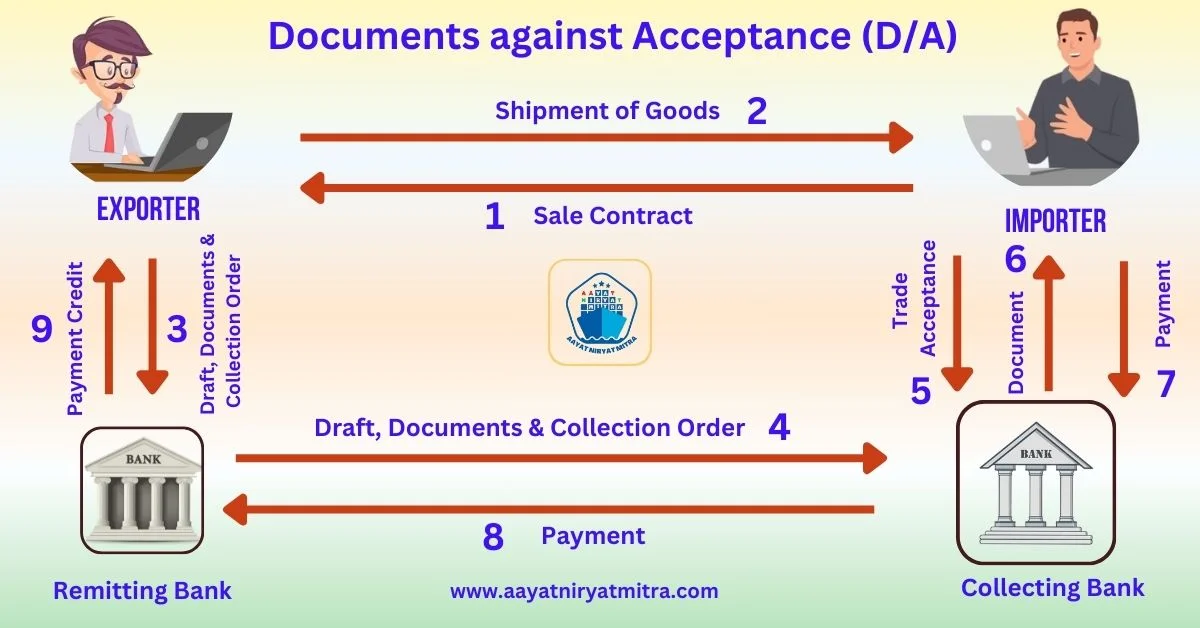Explore the world of international trade finance and learn about Documents against Acceptance (D/A), a popular way for resolving cross-border transactions with postponed payment conditions. This comprehensive book will enlighten you on the D/A procedure, from its beginnings to its practical uses, allowing you to make educated decisions and optimize your international trade processes.
Introduction:
Documents against Acceptance (D/A) are a cornerstone of trade finance in the dynamic world of international trade, allowing the exchange of commodities and services across borders. The exporter releases shipping documents to the importer’s bank, which keeps them until the importer accepts a time draft (bill of exchange) drawn on them. The importer’s bank releases the shipping paperwork upon receipt of the time draft, allowing the importer to take possession of the goods.
What are Documents against Acceptance (D/A)?
Documents Against Acceptance (D/A) is a trade financing technique in which the exporter orders their bank to provide shipping papers to the importer’s bank in exchange for time draft acceptance. The time draft is a bill of exchange drawn on the importer that serves as a promissory note guaranteeing payment on a specific date. The shipping paperwork is held by the importer’s bank until the importer accepts the time draft, signifying their acceptance.
Also Read | Example of D/A Documents against Acceptance
How does Documents against Acceptance (D/A) work?
The D/A process typically involves the following steps:
- Contract of Sale: The exporter and importer sign a sales contract stating the details of the transaction, including the items to be sent, the agreed-upon price, and payment conditions.
- Shipment and Documentation: The exporter dispatches the items and creates all shipment documentation, including a commercial invoice, packing list, and bill of lading.
- Presentation of Documents and Time Draft: The exporter visits their bank with the shipping documentation and a time draft. The time draft provides the amount owed, the payment date, and the information of the importer.
- Release of Documents: The exporter’s bank sends the shipping papers to the importer’s bank, along with instructions to release them upon acceptance of the time draft.
- Acceptance of Bill of Exchange: The importer receives the time draft from the importer’s bank. The importer signs the time draft, expressing their willingness to pay the given amount on the agreed-upon date.
- Release of Goods: The importer’s bank releases the shipping paperwork to the importer upon receipt of the time draft, allowing them to clear customs and gain ownership of the goods.
- Payment: The importer makes the agreed-upon payment to their bank upon the due date specified in the bill of exchange.
Advantages of Documents against Acceptance (D/A)
D/A offers several advantages for both exporters and importers:
For Exporters:
- Reduced Payment Risk: Payment is guaranteed upon acceptance of the bill of exchange, minimizing the risk of non-payment.
- Improved Cash Flow: Facilitates earlier payment compared to open account terms, enhancing cash flow.
- Retention of Control: The exporter retains control of the goods until the bill of exchange is accepted.
For Importers:
- Deferred Payment: Allows for deferred payment, providing more time to arrange financing.
- Goods Inspection: Allows inspection of the goods before accepting the time draft.
- Reduced Banking Costs: Typically less expensive than other trade finance methods, such as Letters of Credit (LCs).
Disadvantages of Documents against Acceptance (D/A)
D/A also has some drawbacks:
- Acceptance Risks: There is a risk that the importer may not accept the bill of exchange, leading to payment delays.
- Limited Credit Protection: D/A does not provide the same level of credit protection as other trade finance methods, such as LCs.
- Potential Delays: The time draft may not be accepted promptly, delaying payment and goods release.
FAQs on Documents against Acceptance (D/A):
-
Q: What are Documents against Acceptance (D/A)?
Ans: D/A is a trade term where the release of shipping and title documents by the seller’s bank to the buyer is contingent upon the buyer’s acceptance of a time draft (a type of bill of exchange) drawn on the buyer.
-
Q: How does Documents against Acceptance work?
Ans: The seller ships the goods and provides the buyer with the necessary shipping documents along with a time draft. The buyer accepts the draft, acknowledging the obligation to pay at a specified future date, and gains control of the documents.
-
Q: What documents are typically involved in a D/A transaction?
Ans: Common documents include the commercial invoice, bill of lading, packing list, and a time draft that requires the buyer’s acceptance.
-
Q: What is a time draft in a D/A transaction?
Ans: A time draft is a written order from the seller to the buyer, requiring the buyer to pay a specified amount at a future date. The acceptance of the time draft by the buyer is necessary for the release of shipping documents.
-
Q: What is the role of the banks in a D/A transaction?
Ans: The seller’s bank acts as a custodian of the shipping documents and the time draft. The buyer’s bank may facilitate the acceptance process and ensure payment is made at the agreed-upon future date.
-
Q: Can the buyer inspect the goods before accepting the time draft in a D/A transaction?
Ans: The ability of the buyer to inspect the goods before accepting the time draft depends on the terms negotiated between the buyer and the seller. It’s important to clearly outline inspection procedures in the sales contract.
-
Q: Is D/A a secure method of payment for the seller?
Ans: D/A provides a level of security for the seller as it ensures that the buyer accepts a time draft, creating a legally binding obligation to pay at a future date. However, the seller does not receive immediate payment.
-
Q: What risks does the buyer face in a D/A transaction?
Ans: The primary risk for the buyer is the obligation to make payment at a future date, as specified in the accepted time draft. Failure to honor the draft can have financial and legal consequences.
-
Q: Can D/A transactions be used in international trade?
Ans: Yes, D/A is commonly used in international trade, especially when there is an established trust between the buyer and the seller. It allows for deferred payment while providing security through the acceptance process.
-
Q: What happens if the buyer does not accept the time draft in a D/A transaction?
Ans: If the buyer does not accept the time draft, the shipping documents will not be released, and the buyer may lose control of the goods. The seller may take legal action for non-acceptance.
-
Q: Is D/A similar to a Letter of Credit (LC)?
Ans: While both D/A and LC involve banks and documents in international trade, the key difference is that D/A relies on the buyer’s acceptance of a time draft for payment, whereas an LC involves a bank’s promise to pay upon compliance with specified terms.
-
Q: What are the key considerations for using Documents against Acceptance?
Ans: Carefully evaluate the creditworthiness
-
Q: What are the different types of Documents against Acceptance?
Ans: There are two main types of D/A:
1. D/A at Sight: Acceptance of the bill of exchange is required immediately upon presentation.
2. D/A at Usance: Acceptance is required at a predetermined date after the presentation of the bill of exchange.
Conclusion:
Documents against Acceptance (D/A) serve as a widely used and versatile trade finance mechanism, facilitating international transactions by balancing the risk and control between the exporter and the importer. For exporters, D/A offers reduced payment risk, improved cash flow, and retention of control over the goods. For importers, D/A provides deferred payment, enhanced negotiating power, and reduced banking costs. While D/A carries some risks, such as acceptance risk and limited credit protection, it remains a popular choice for international trade due to its simplicity and cost-effectiveness.
If you discover an error in the “Documents against Acceptance (D/A): A Comprehensive Guide 2024” information provided to us, please notify us immediately via the comment box and email; if the information provided by you is correct, We will change it.
If you enjoyed this article, please share it with your friends. Please visit Aayat Niryat Mitra | Import Export Friend for more information on this and other topics. Thank you for stopping by.


3 thoughts on “Documents against Acceptance (D/A): A Comprehensive Guide 2024”